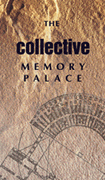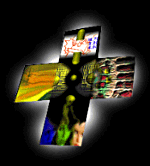  |
  |
ACEN's projects have included collaborative story writing, the creation of collective spaces (much like MOOs and MUDs), and other textual and textual-visual projects. However, their existence as part of the WELL makes its accessibility limited to paying members of the BBS. Participation is limited to members, and access to completed or in-progress projects is equally restricted.
Three projects that have been going on for a few years reflect the possibilities that the Internet offers in the area of artistic cooperation: the University of Syracuse Art Department's Cooperative Graphics project, the Collective Memory Palace project , and the SITO/OTIS SYNERGY project. Each exploits a different side of the technological and artistic possibilities offered by high-speed networking and digital image processing and creation.
Projects with a larger possible range became much more feasible with increased visibility and
ubiquity of the Internet.  The ChainArt Project of the
University of Oregon's Computer Art department involved a coordinated international effort at collective
digital image manipulation using the Internet to exchange images and facilitate communication between
artists. An initial image was uploaded to a designated ftp site from where it would be downloaded and
manipulated by the first group, then uploaded again so that the next group could repeat the process, and
continued successively until every member of the group had had a chance to contribute. The final projects
eventually were placed on display in Syracuse University's Computer Graphics Program Web Page.
The ChainArt Project of the
University of Oregon's Computer Art department involved a coordinated international effort at collective
digital image manipulation using the Internet to exchange images and facilitate communication between
artists. An initial image was uploaded to a designated ftp site from where it would be downloaded and
manipulated by the first group, then uploaded again so that the next group could repeat the process, and
continued successively until every member of the group had had a chance to contribute. The final projects
eventually were placed on display in Syracuse University's Computer Graphics Program Web Page.
Other variations on this form of chain art include SYNERGY's Corpses project , and Syracuse University's Digital Cooperations projects. SITO's corpses involved the merging of three different pieces created by three different people (previously designated as head, body or legs), in the tradition of the dadaesque Exquisite Corpse.
A different variation of the Corpse is the Grid, where a starting "square" in a two-dimensional array is specified and contiguous squares are created by other artists. A patchwork image, a Grid presents the work of multiple artists as one collective enterprise with discreet contributions separable from the whole.
The SYNERGY approach to Chain art took off with its PANIC project in 1994. Originally an internetworked multi-person manipulation of images captured at a rave party in Chicago, PANIC articulated clearly the ideas behind cooperative digital manipulation and creation of images and the possibilities offered by enhanced internetworking. A project with multiple variants, PANIC collaborative creations have included Chain images, Grids and Corpses more fully integrated into the idea of using the Internet as a vehicle for computerized artistic interaction.
SITO's Mongocosm project takes a different turn. An initial image is presented, to which artists can link other images and HTML documents. Thus, users are creating a navigable hypertexted space, " a 4D narrative or a 3D micro/macro zoom-in/out" as presented by Ed Stasny ( Mongocosm description , paragraph 2).
 A different form of cooperative artistic experience can be seen with The Collective Memory Palace project.
This project, initiated by Serena Lin, graduate student of visual arts at the University of Maryland, consists
of a virtual three-dimensional space, which serves as a unifying framework for a collective memory
experience. Any web-capable user can contribute, creating a room in this space, connecting it to existing
rooms, and presenting, following a loosely-specified format, a visual and textual expression. While the
bottom line of this collective enterprise is hypertextual, the visual three-dimensional model of the Palace
establishes a new model for cooperation, in which the hypertextual is contained within the virtual walls of a three-
dimensional, explorable environment. Unlike Chain art, each contribution becomes an inseparable part of
the whole creation, independent of the notion of an "original" and a "manipulated" creation.
A different form of cooperative artistic experience can be seen with The Collective Memory Palace project.
This project, initiated by Serena Lin, graduate student of visual arts at the University of Maryland, consists
of a virtual three-dimensional space, which serves as a unifying framework for a collective memory
experience. Any web-capable user can contribute, creating a room in this space, connecting it to existing
rooms, and presenting, following a loosely-specified format, a visual and textual expression. While the
bottom line of this collective enterprise is hypertextual, the visual three-dimensional model of the Palace
establishes a new model for cooperation, in which the hypertextual is contained within the virtual walls of a three-
dimensional, explorable environment. Unlike Chain art, each contribution becomes an inseparable part of
the whole creation, independent of the notion of an "original" and a "manipulated" creation.
 One cooperative art project sponsored by SITO:SYNERGY is Hygrid , created by Ed Stasny. HYGRID is an expansion of the Grid concept
which uses a new paradigm for interaction, cooperative creation, and the visualization of the same. Registered
artists (registration in SITO is free to the Internet community) can add contiguous grid pieces to a central
piece, creating a seamless union. Each contiguous piece can in turn become a central piece, with three
more sides to which artists can add. The difference between the Hygrid and a standard grid is that what is
seen by an observer depends on the piece that is in the center of the viewing area at that particular moment.
The observer in fact "traverses" the Hygrid by clicking on contiguous images to make them the central
image. The hyper-linked foundation of the Hygrid makes observation dependent on navigation. As Ed
Stasny says to the observer in his tutorial for the Hygrid: "your
brain might fuzzle at the thought that going 'up and right' is not the same as going 'right and up'."
One cooperative art project sponsored by SITO:SYNERGY is Hygrid , created by Ed Stasny. HYGRID is an expansion of the Grid concept
which uses a new paradigm for interaction, cooperative creation, and the visualization of the same. Registered
artists (registration in SITO is free to the Internet community) can add contiguous grid pieces to a central
piece, creating a seamless union. Each contiguous piece can in turn become a central piece, with three
more sides to which artists can add. The difference between the Hygrid and a standard grid is that what is
seen by an observer depends on the piece that is in the center of the viewing area at that particular moment.
The observer in fact "traverses" the Hygrid by clicking on contiguous images to make them the central
image. The hyper-linked foundation of the Hygrid makes observation dependent on navigation. As Ed
Stasny says to the observer in his tutorial for the Hygrid: "your
brain might fuzzle at the thought that going 'up and right' is not the same as going 'right and up'."
Hygrid offers a new space for cooperative creation. Unlike Grids, Chain art and Corpses, the Hygrid can only be observed, added to or expanded upon through the World Wide Web. It relies on a perl script running on a UNIX workstation for visualization and traversing. It requires the hyperlinking capabilities offered by html for user interaction.